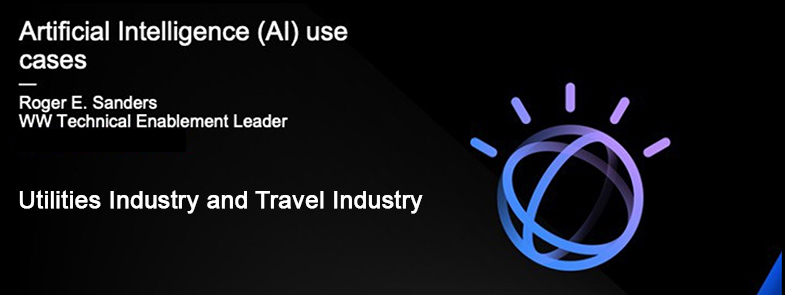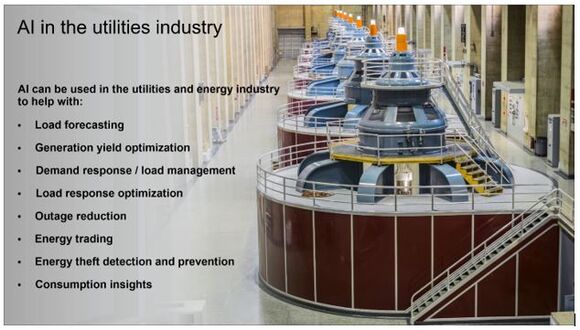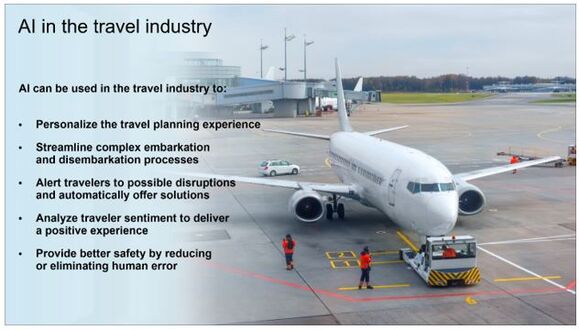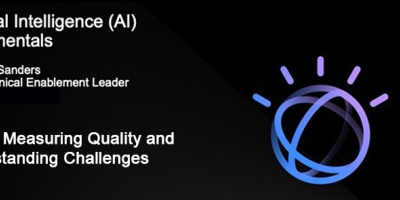The utilities sector is comprised of companies that consistently provide electricity, natural gas, and/or water to individuals and businesses. (This sector also includes companies that provide electricity through renewable energy sources, such as solar or hydro-electric power, as well as companies that generate and sell energy to utility companies.)
AI in the Utilities Industry
Although they earn profits, utilities are part of the public service landscape, and therefore are heavily regulated. Even so, the utilities industry, as-a-whole, is trying to become a more technology-driven, sophisticated marketplace.
Many utility companies already rely on smart devices for optimization of infrastructure and to balance supply with demand. And artificial intelligence (AI), machine learning (ML), and deep learning (DL) use cases in customer operations, outage management, infrastructure and asset management, supply chain, and market operations (just to name a few) hold enormous potential for the utility sector.
Areas in which AI, ML, and DL might be used in the utilities industry include:
- Load forecasting: Each year, electricity consumers in the US spend billions more than is necessary to keep the lights on, in part because the utility sector has been overestimating its needs for decades. An analysis done by the Rocky Mountain Institute (RMI) in 2017 concluded that load predictions have been consistently over-forecast by 1% each year, which means that a decade-out planning strategy results in a 10% over-estimation of demand (which in turn means that more power generation and distribution equipment is being built than is needed). AI could remedy this by better forecasting supply and demand and by finding ways to keep the total cost of electricity generation (which includes fuel costs, transmission costs, labor costs, and maintenance costs) as low as possible, without compromising the ability to meet load demands.
- Generation yield optimization: Energy production depends on the availability of power generation equipment. Therefore, electric utilities could use ML models to optimize the startup and shut down of large rotating equipment such as turbines and wind generators, as well as identify potential defects and predict future maintenance needs so the interruption of operations is minimized as much as possible.
- Demand response (load management): Demand response (DR), also known as load management, temporarily shifts customer energy loads during peak demand hours to off-peak periods, thereby alleviating the burden on the power grid during periods of high demand. Reducing peak energy demand helps defer the need for new power plants, power purchases, and additions to transmission and distribution capacity. AI could be used to automate DR and make the process smarter. In fact, it is estimated that ML could be used to unlock up to 6 gigawatts (GW) of demand-side flexibility which could be shifted during peak periods without affecting end users.
- Load response optimization: Load-response programs offer customers economic incentives such as lower electricity rates to change when their energy loads are the heaviest. (Roughly 90% of the peak load reduction in the US comes from load response measures.) AI could help utilities craft electricity price incentives that maximize their margins while minimizing customer churn. It could also be used to create individualized offers and services to help utilities retain their most profitable customers.
- Outage reduction: Since the U.S. Energy Information Administration (EIA) began collecting reliability data in 2013, U.S. electricity customers have consistently experienced an average total of two hours (106 minutes to 118 minutes) of power interruptions each year. And the length of these power interruptions is increasing because of major weather events and an aging and strained infrastructure. Similarly, water main breaks are costly for water utilities. Given the volume of data that utilities generate, AI could be used to analyze grid and weather data, to proactively identify patterns that lead to outages and poor power quality. In the U.S., Duke Energy is already using ML to analyze smart meter voltage data and meter events to identify anomalies and minimize problems on their electric distribution grid. For water utilities, AI can be used to identify data patterns that indicate a break event is imminent.
- Energy trading: With customers generating their own renewable energy with solar panels and sending the excess back to the grid, platforms are emerging that enable peer-to-peer trading between producers and consumers. AI could be used to match producers with consumers, in real time, as supply and demand changes. And ML models could analyze historical weather data to accurately predict when more consumer-generated energy would be available for peak periods. (Similar models could be used to predict when weather might cause outages, helping utilities prepare in advance so power can be restored faster when such outages occur.)
- Energy theft: The theft of energy is a huge problem in some developing countries, like Brazil where theft accounts for up to 40% of the electricity distributed. By analyzing usage patterns, location, payment history, and customer behavior, ML models could detect anomalies and flag suspicious behavior, in real-time.
- Consumption insights: According to the U.S. Energy Information Administration (EIA), in 2020, the average annual electricity consumption for a U.S. residential utility customer was 10,715 kilowatt-hours (kWh), an average of about 893 kWh per month. However, no two households use electricity the exact same way, and some appliances consume more electricity than others. Using AI, meter data could be analyzed to create consumption profiles of a household’s appliances and show how much each contributes to the energy bill. This information could then be provided to consumers as a way to help them save on their energy costs.
Sources:
How AI Can Help Power Utilities Meet Modern Challenges: (APRO Software)
https://apro-software.com/ai-and-power-utilities/
5 Ways Machine Learning Is Revolutionizing the Energy and Utility Industry: (BlueOrange)
https://blueorange.digital/5-ways-machine-learning-is-revolutionizing-energy-and-utilities/
Real World Applications of Machine Learning in Utilities: (IndustryWired)
https://industrywired.com/real-world-applications-of-machine-learning-in-utilities/
How AI and Data Science is Changing the Utilities Industry: (KDNuggets)
https://www.kdnuggets.com/2019/01/how-ai-data-science-changing-utilities-industry.html
AI in the Travel Industry
Before the outbreak of the coronavirus pandemic in 2020, the travel and tourism industry was one of the world’s largest industries with a global economic contribution of over $7.6 trillion U.S. (2016). Globally, travel and tourism's direct contribution to the worldwide gross domestic product (GDP) fell to approximately 4.7 trillion U.S. dollars in 2020. Unlike other industries, travel and tourism incorporates many industries, including lodging, transport, attractions, travel companies, and more. (In its broadest sense, tourism is defined as when people travel and stay in places outside of their usual environment for less than one consecutive year for leisure, business, health, or other reasons.)
Pandemic aside, the travel and tourism industry has often been at the forefront of technology adoption, especially when it comes to digital technology trends. This industry comfortably welcomed the internet era with websites and online advertising quickly becoming the primary method used to reach customers. From there, it moved into mobile, catalyzed by the social media craze – airlines, resorts, hotels, and car rental quickly took a mobile-first approach in an attempt to be everywhere, all the time.
Likewise, travelers have been equally enthusiastic about adopting new technology to make travel simpler and more enjoyable. And this has led to tremendous innovation in both products and business models (think Uber, Lyft, and Airbnb). So, it makes sense for such a large industry to utilize technology as groundbreaking as artificial intelligence (AI), machine learning (ML), and deep learning (DL).
Some ways in which AI, ML, and DL might be used in the travel and tourism industry include:
- Customized, personal travel planning: Today, everything a traveler needs to plan a trip is available on the internet. Using a variety of websites, travelers can plan where they want to go, compare price options, weigh budgets, and make bookings and cancellations. So, AI could be used to analyze the data travelers leave on these websites to offer personalized travel planning that takes information such as a traveler’s preferences, budget, location, eating habits, and so on, into consideration. And chatbots using natural language processing (NLP) could be deployed to accomplish even more complex personalization.
- Traveler ID verification: Travel requires repeated scrutiny of travel documents by different sets of people – there are complex embarkation and disembarkation processes when traveling, especially when traveling between countries or utilizing cruise liners. AI technology in the form of facial recognition can bring an end to these tiresome paper-bound processes, enabling travelers to move seamlessly through airports, customs, and immigration, without having to have travel documents scrutinized at every step.
- Travel disruption management: Thousands of trips are disrupted every day. Things like the weather, maintenance, computer outages, and natural disasters can cause major inconveniences and losses – especially for business travelers. Using information about weather patterns and current delays, predictive analytics could be used to alert travelers to possible disruptions and automatically offer solutions. AI together with an NLP-based chatbot that can scale during an emergency (for example, when a hurricane is expected to make landfall) would be invaluable. In such situations, travelers want instant answers to all kinds of questions and limited staff often cannot handle queries fast enough. Assistance from AI would go a long way in easing the pain of travelers in these types of scenarios.
- Improved traveler sentiment: There are scores of tools available that could be used to mine social media for sentiment regarding a traveler’s journey – before the trip is started, during actual travel, and when the trip is over. Is a traveler frustrated because of a delayed flight or by a hotel room that’s not what was expected? If they post their frustration on social media, AI could be used to analyze the context, and reach out automatically, in real time, to intervene and deliver a more positive experience.
- Improved traveler safety: Safety is always a concern when traveling. Trains, airplanes, ships, and automobiles carry millions of passengers a day to and from destinations. AI systems could help remove human error by learning from the real-time systems that are present in many of these modes of transport. AI could also be used to augment a crew member’s awareness of their surrounding environment as well as their own physical, emotional, and mental state, to help provide additional safety measures and avert disaster and loss of life.
Sources:
Global tourism industry - statistics & facts: (Statista)
https://www.statista.com/topics/962/global-tourism/#dossierKeyfigures
Artificial Intelligence in Travel and Hospitality: (Altexsoft)
https://www.altexsoft.com/ai-artificial-intelligence-in-travel/
7 Successful Applications of AI & Machine Learning in the Travel Industry: (Hackernoon)
https://hackernoon.com/successful-implications-of-ai-machine-learning-in-travel-industry-3040f3e1d48c
Four Ways AI is Re-imagining the Future of Travel: (Mindtree)
https://www.mindtree.com/blog/four-ways-ai-re-imagining-future-travel
How Utilities Can Use Artificial Intelligence to Upgrade Customer Experience: (TechSee)
https://techsee.me/blog/ai-in-utilities/
AI in Water: 10 Ways AI is Changing the Water Industry: (Innovyze)
https://www.innovyze.com/en-us/blog/ai-in-water-10-ways-ai-is-changing-the-water-industry
How Utilities Can Use Data And AI To Turn Every Interaction Into A Marketing Opportunity: (Forbes)
https://www.forbes.com/sites/forbescommunicationscouncil/2021/06/08/how-utilities-can-use-data-and-ai-to-turn-every-interaction-into-a-marketing-opportunity/?sh=1def7b352b25
How much electricity does an American home use? (U.S. Energy Information Administration)
https://www.eia.gov/tools/faqs/faq.php?id=97&t=3





































 More than ever, there is a demand for IT to deliver innovation. Your IBM i has been an essential part of your business operations for years. However, your organization may struggle to maintain the current system and implement new projects. The thousands of customers we've worked with and surveyed state that expectations regarding the digital footprint and vision of the company are not aligned with the current IT environment.
More than ever, there is a demand for IT to deliver innovation. Your IBM i has been an essential part of your business operations for years. However, your organization may struggle to maintain the current system and implement new projects. The thousands of customers we've worked with and surveyed state that expectations regarding the digital footprint and vision of the company are not aligned with the current IT environment. TRY the one package that solves all your document design and printing challenges on all your platforms. Produce bar code labels, electronic forms, ad hoc reports, and RFID tags – without programming! MarkMagic is the only document design and print solution that combines report writing, WYSIWYG label and forms design, and conditional printing in one integrated product. Make sure your data survives when catastrophe hits. Request your trial now! Request Now.
TRY the one package that solves all your document design and printing challenges on all your platforms. Produce bar code labels, electronic forms, ad hoc reports, and RFID tags – without programming! MarkMagic is the only document design and print solution that combines report writing, WYSIWYG label and forms design, and conditional printing in one integrated product. Make sure your data survives when catastrophe hits. Request your trial now! Request Now. Forms of ransomware has been around for over 30 years, and with more and more organizations suffering attacks each year, it continues to endure. What has made ransomware such a durable threat and what is the best way to combat it? In order to prevent ransomware, organizations must first understand how it works.
Forms of ransomware has been around for over 30 years, and with more and more organizations suffering attacks each year, it continues to endure. What has made ransomware such a durable threat and what is the best way to combat it? In order to prevent ransomware, organizations must first understand how it works. Disaster protection is vital to every business. Yet, it often consists of patched together procedures that are prone to error. From automatic backups to data encryption to media management, Robot automates the routine (yet often complex) tasks of iSeries backup and recovery, saving you time and money and making the process safer and more reliable. Automate your backups with the Robot Backup and Recovery Solution. Key features include:
Disaster protection is vital to every business. Yet, it often consists of patched together procedures that are prone to error. From automatic backups to data encryption to media management, Robot automates the routine (yet often complex) tasks of iSeries backup and recovery, saving you time and money and making the process safer and more reliable. Automate your backups with the Robot Backup and Recovery Solution. Key features include: Business users want new applications now. Market and regulatory pressures require faster application updates and delivery into production. Your IBM i developers may be approaching retirement, and you see no sure way to fill their positions with experienced developers. In addition, you may be caught between maintaining your existing applications and the uncertainty of moving to something new.
Business users want new applications now. Market and regulatory pressures require faster application updates and delivery into production. Your IBM i developers may be approaching retirement, and you see no sure way to fill their positions with experienced developers. In addition, you may be caught between maintaining your existing applications and the uncertainty of moving to something new. IT managers hoping to find new IBM i talent are discovering that the pool of experienced RPG programmers and operators or administrators with intimate knowledge of the operating system and the applications that run on it is small. This begs the question: How will you manage the platform that supports such a big part of your business? This guide offers strategies and software suggestions to help you plan IT staffing and resources and smooth the transition after your AS/400 talent retires. Read on to learn:
IT managers hoping to find new IBM i talent are discovering that the pool of experienced RPG programmers and operators or administrators with intimate knowledge of the operating system and the applications that run on it is small. This begs the question: How will you manage the platform that supports such a big part of your business? This guide offers strategies and software suggestions to help you plan IT staffing and resources and smooth the transition after your AS/400 talent retires. Read on to learn:
LATEST COMMENTS
MC Press Online